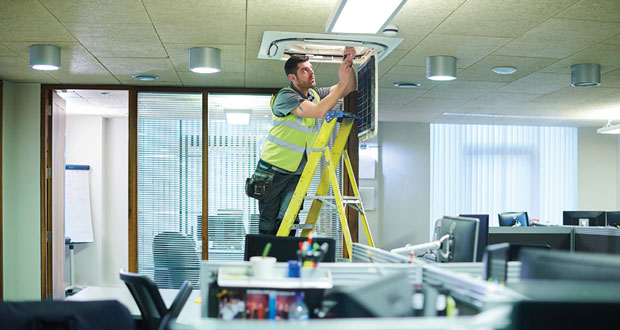 Energy efficiency starts with engineers, not equipment says Greg Hill, Director of Product at Joblogic
Energy efficiency starts with engineers, not equipment says Greg Hill, Director of Product at Joblogic
The facilities management industry loves a shiny new solution. Smart sensors, AI-powered building systems, the latest energy-efficient kit. But often, the biggest opportunity for energy savings is walking around your building right now, carrying a toolbox.
Engineers see everything. They know which air handling unit sounds like it’s working too hard. They spot the pump that’s running when it shouldn’t be. Yet when energy and sustainability strategies get discussed, they’re rarely in the room, and that needs to change.
THE COSTLY KNOWLEDGE GAP
I recently heard about a hospital where an engineer noticed an HVAC unit running flat out 24/7 during routine maintenance. He knew it was burning through energy, but there wasn’t a clear way to flag this as urgent. So, he noted it down somewhere, it got lost in the shuffle, and three months later someone finally investigated why the energy bills had spiked.
This happens everywhere. Engineers spot inefficiencies developing but lack direct channels to decision-makers. They’re the ones who really understand equipment behaviour patterns but aren’t consulted on sustainability planning. Every day they see problems brewing but are tasked with treating the symptoms instead of the root cause.
The disconnect is expensive. When the people who understand your building’s quirks can’t easily share that knowledge, minor issues become major waste. A lot of the time it’s not a technology problem; it’s a communication problem.
TRADITIONAL MAINTENANCE GAPS
We’ve all worked with planned preventive maintenance schedules. Change filters monthly. Service pumps quarterly. Check, tick, move on. The trouble is that this approach often creates its own inefficiencies.
You end up servicing perfect equipment while missing the unit that’s slowly degrading. Engineers rush through predetermined rounds, fixing what’s obviously broken, never getting time to investigate why certain problems keep recurring. Meanwhile, energy-wasting faults accumulate because nobody’s looking at the bigger picture.
The industry talks about condition-based maintenance as the answer. It can be, but only if engineers have the tools and knowledge to capture and report what they’re seeing.
WHEN DIGITAL TOOLS ACTUALLY HELP
Here’s where technology can make a real difference. Not by replacing human judgment, but by amplifying it. When engineers can instantly log observations, access equipment history, and see performance trends on their phones, everything changes.
One HVAC contractor I know reduced energy waste by 60 per cent after implementing a platform that prioritised jobs by efficiency impact. He didn’t need any extra equipment, just a better way to access information.
When you give your engineers complete visibility, units running overnight get flagged immediately, recurring faults get spotted and properly investigated. Engineers can see which issues cost the most and tackle them first.
The key is making data capture painless. Nobody wants to fill in forms after a long day. But when logging information takes seconds on-site, adoption happens naturally. Add intelligent job routing and suddenly you’re saving fuel, reducing repeat visits, and fixing problems before they waste serious energy.
GETTING PAST THE RESISTANCE
Plenty of engineers are sceptical of new technology. They’ve seen systems come and go, each promising to ‘revolutionise’ their work, most just adding complexity. To drive adoption, engineers need to see immediate benefits, meaning less paperwork, fewer wasted journeys, and arriving on-site with the right parts.
Contractors need proof that efficiency gains translate to more revenue and facilities managers need clear connections between better data and hitting targets.
I’ve seen implementations fail because they focused on features rather than people. The successful ones start by asking engineers what they dislike about their current setup, then they get to work fixing those specific problems.
When people see improvements in their daily work, resistance slowly melts away.
WHERE THE PRESSURE’S GREATEST
Some sectors feel this challenge more acutely:
- Healthcare facilities manage thousands of critical assets where failure affects patient care.
- Schools struggle with outdated heating systems and meeting efficiency targets on shoestring budgets.
- Social housing providers face stringent environmental requirements but often lack basic digital infrastructure.
These high-pressure, asset-rich environments show why the traditional approach is breaking down. They also demonstrate where empowering engineers can make the biggest difference.
When every kilowatt matters and every breakdown has a noticeable impact, having your frontline teams properly equipped is essential.
MAKE THE SHIFT
The path forward isn’t complicated, but it does require a change in thinking. Engineers are your early warning system for efficiency problems, gathering intelligence that can (and should) inform every energy decision.
When given proper tools and visibility into energy priorities, engineers evolve from task executors to active contributors. They start suggesting improvements based on what they see daily, spot trends before they become crises, and create feedback loops that continuously improve performance.
The technology enabling this already exists and works well. What holds organisations back is the outdated notion that engineers should just follow schedules and fix breakdowns. Until the industry recognises the people maintaining equipment are as crucial as the equipment itself, even the best sustainability strategies will underperform.
Your next big efficiency gain probably won’t come from installing smarter kit. It’ll come from finally listening to the smart people who already know where energy is being wasted and giving them the tools to do something about it.





